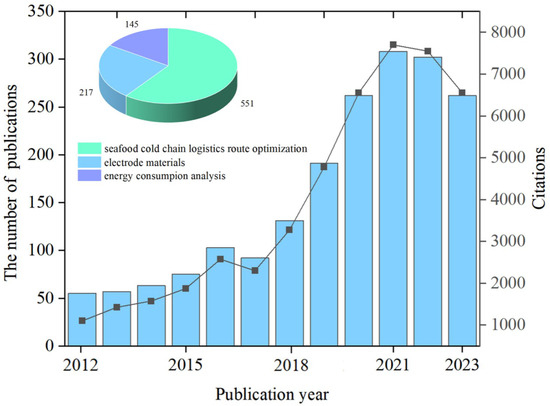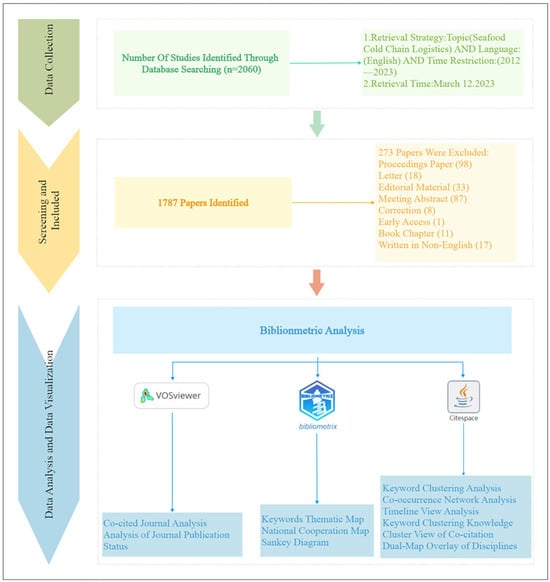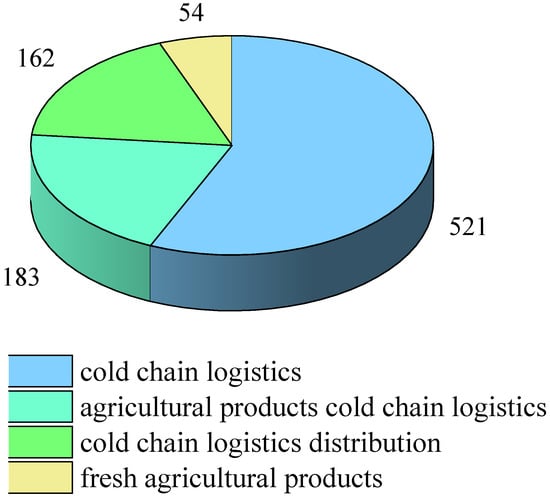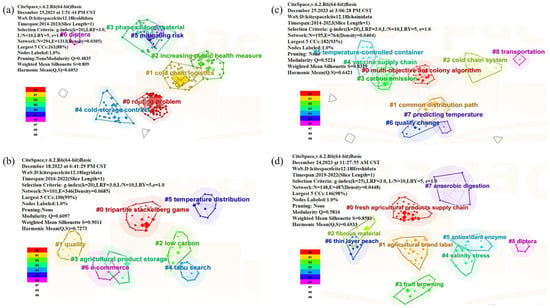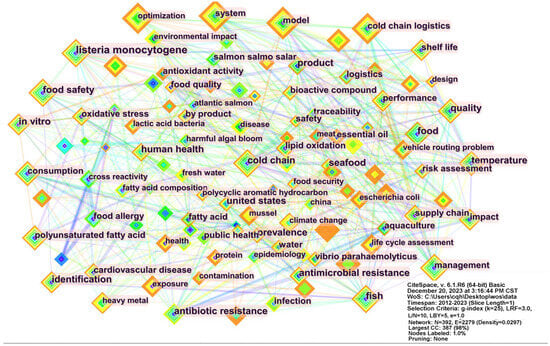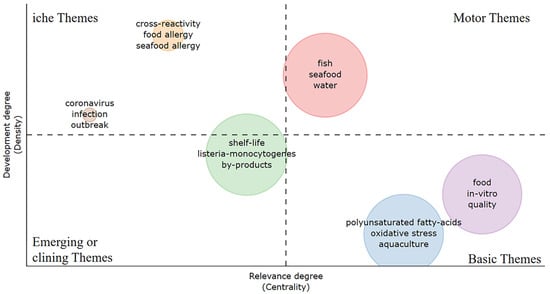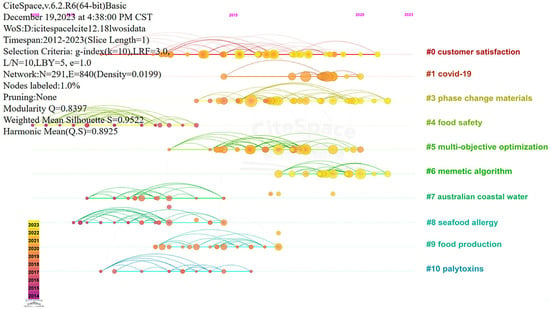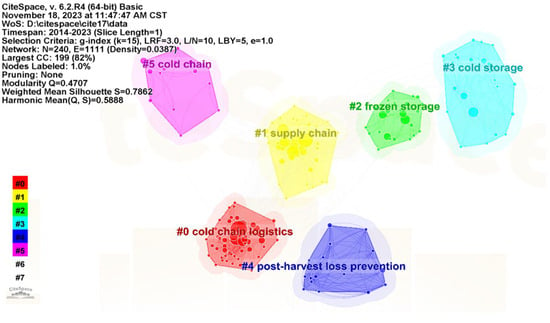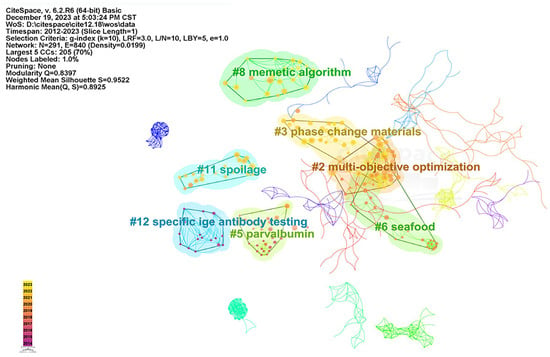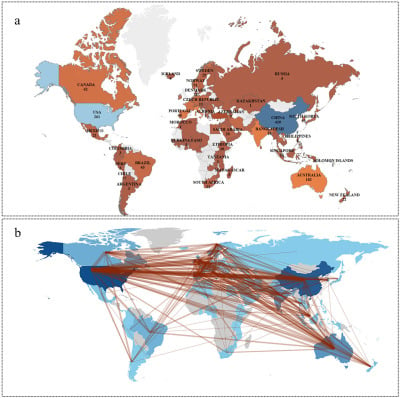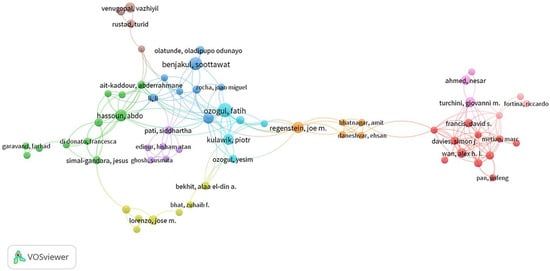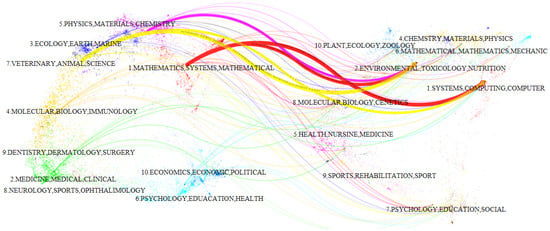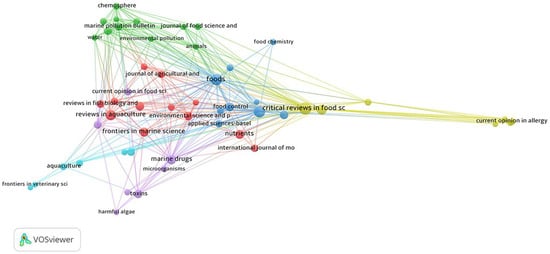Abstract
The development of cold chain logistics for seafood plays a pivotal role in guaranteeing food safety, promoting economic progress, reducing losses, and fostering sustainable development, thereby enhancing the overall efficiency of the seafood supply chain. This study conducted a comprehensive investigation into the primary research focuses of the seafood cold chain logistics field using the literature on visualization analysis software (CiteSpace (6.2.R6), VOSviewer (1.6.20), and RStudio Bibliometrix (4.4.0)). A total of 1787 articles were collected and further analyzed from the China National Knowledge Infrastructure (CNKI), Web of Science (WOS), and Google databases over 12 years, establishing a knowledge framework for research in seafood cold chain logistics. Through the utilization of keyword clustering and emerging analysis techniques, the study constructed a knowledge map that intuitively describes the emerging trends and key hotspot in this field. The results indicate a growing trend in the seafood cold chain logistics field, with disciplines such as mathematics, systems, and physics being notably prominent. Key terms such as “cold chain logistics”, “highlighted supply chain management”, “frozen storage techniques”, “cold storage practices”, “post-harvest loss prevention strategies”, and “optimization of the cold chain” frequently appear in the literature, highlighting the importance of interdisciplinary academic research in these areas. By exploring the current development of the seafood cold chain logistics field, we strengthen the research gaps in the literature and propose future research directions. Therefore, well-conducted bibliometric studies can play a crucial role in advancing the field by providing comprehensive insights, facilitating scholarly discussions, identifying knowledge gaps, generating new research ideas, and showcasing their intended contributions to the field.
1. Introduction
With the improvement of living standards, there is increasing attention to the nutritional value of food [1]. The proportion of fresh foods, such as seafood, in daily diets is steadily rising [2,3]. However, preserving the freshness of seafood at room temperature is challenging, necessitating the support of cold chain logistics for storage, transportation, and distribution [4,5,6]. Additionally, recent food safety incidents have improved public awareness and concern about food safety [7]. Health-conscious eating habits have become a key issue in people’s lives, leading to a growing focus on the quality and safety of fresh foods [8,9]. Ensuring the quality of fresh foods requires maintaining their safety and smooth flow throughout the distribution process [10,11].
Global requirements for fishery products are becoming increasingly stringent [12]. The FDA Food Safety Modernization Act (FSMA), enacted by the United States in 2011, enhanced the FDA’s regulatory authority over domestic and imported food safety supervision, imposing more rigorous food safety requirements on food manufacturers [13,14,15]. In 1997, the European Union introduced the Seafood Quality Standards Act, mandating that food suppliers comply with specified quality assurance provisions and establish various seafood quality standards to ensure the provision of high-quality seafood that is healthy, safe, nourishing, and environmentally beneficial [16,17,18]. In China, policies have also played a crucial role in promoting the rapid rise of cold chain logistics [19]. For example, Chinese government’s “Development Plan for Agricultural Product Cold Chain Logistics” in 2010 and the “14th Five-Year Plan for Cold Chain Logistics Development” in 2021 have provided a top-level design for the continuous improvement of the industry [20,21]. It can be seen that the field of cold chain logistics has received the attention of governments and has received policy support.
Cold chain logistics management plays a pivotal role in ensuring the quality and safety standards of fishery products [22]. The effective use of cold chain logistics is essential not only to maintain the freshness and quality of seafood, but also to raise standards in the cold chain logistics industry [23,24,25,26]. The seafood industry plays a vital role in the global food supply chain, ensuring food safety and nutrition [27,28]. Cold chain logistics, which involves the temperature control and transportation of seafood, is indispensable for maintaining the quality and safety of seafood products [29,30]. With the rapid growth of the global economy and the increasing demand for high-quality seafood, cold chain logistics has been widely adopted [31,32]. Consequently, an increasing number of scholars are exploring seafood cold chain logistics.
The number of publications per year serves as a valuable indicator of growth trends in seafood cold chain logistics research. Figure 1 illustrates the annual publication and citation counts of seafood cold chain logistics documents, revealing an exponential surge of publications in the seafood cold chain logistics field over the past 12 years. Despite the rapid growth of the seafood industry, comprehensive reviews of research in the field of seafood cold chain logistics are relatively scarce. Analyzing and summarizing past research is a valuable academic endeavor, as the theoretical and empirical contributions of individual studies are crucial for advancing knowledge within an academic field [33,34,35,36]. Bibliometric analysis can elucidate development trends in seafood cold chain logistics, identify research hotspots, and highlight emerging directions, thereby guiding future research choices and planning [37,38,39,40]. Although numerous researchers have reviewed various aspects of seafood cold chain logistics, such as energy consumption analysis [41], electrode materials [42,43], and route design [44,45], few have employed bibliometrics to explore research hotspots, developing trends, or scientific advancements in this field [46,47].
Figure 1.
The number of published articles regarding the seafood cold chain logistics optimized pathway. The inset is review articles distributions of seafood cold chain logistics, the energy consumption analysis, and the electrode materials.
To fill this gap, this study aims to address six research questions: (1) What are the overall research volume and development trends in seafood cold chain logistics? (2) Which themes and keywords are most prominently featured in the literature? Who are the primary authors of seafood cold chain logistics literature, and how interconnected are these authors? (3) What is the disciplinary distribution of seafood cold chain logistics research? Is it multidisciplinary? (4) What is the geographical distribution of the research? (5) Which countries are involved, and how do they collaborate? (6) Which journals have the highest number of published papers on this topic? Through bibliometric analysis, this study not only provides insights for constructing modern agricultural product cold chain logistics systems but also promotes the development of the fisheries industry. The application of big data technology and advanced management models ensures the freshness and timely delivery of seafood.
2. Materials and Methods
2.1. Bibliometric Analysis
Bibliometrics is a widely used quantitative analysis method in scientific research to study hot topics [48]. CiteSpace (6.2.R6), developed by Professor Chaomei Chen, is specialized bibliometric automation software for scientific literature. It uses mathematical and statistical methods to analyze a large number of publications to describe, evaluate, and predict the current status and trends in science and technology [49]. Compared to other software tools, CiteSpace’s knowledge graph provides clearer and more intuitive analysis and interpretation, helping researchers to achieve different research goals [50]. VOSviewer (1.6.20) is a software tool for constructing and visualizing bibliometric networks, primarily used for analyzing and displaying literature data, especially the relationships between knowledge units [51,52]. RStudio Bibliometrix (4.4.0) is developed in the R language, an open-source environment and ecosystem [53]. It provides rich functionality to help researchers to conduct the quantitative analysis and visualization of scientific literature [54]. Cluster analysis is an important feature in Bibliometrix (4.4.0), which helps researchers identify key themes, authors, journals, etc., in the literature and group them to reveal the structure and patterns of the research field.
2.2. Research Process
This study utilizes CiteSpace (6.2.R6), VOSviewer (1.6.20), and RStudio Bibliometrix (4.4.0) to import collected literature data. It provides an overview of the research status of cold chain logistics for marine products, including aspects such as publishing institutions and authors. Keyword clustering analysis is used to identify hot topics in the research, and keyword co-occurrence analysis is employed to reveal the focal points of the research. Timeline analysis is used to examine the trends in hot topics, and burst keyword analysis is used to track the research frontier. Through keyword co-occurrence analysis, clustering analysis, and burst keyword analysis in this field, this study explores the research hotspots, evolutionary trends, and frontiers in the field of cold chain logistics for marine products.
The research process is illustrated in Figure 2. In the first stage, the data required for the study were collected, and a search strategy was determined. In this study, data for bibliometric research were gathered from the CNKI, Web of Science (WOS), and Google databases. The search was conducted using the keyword “Cold Chain Logistics and Marine Products”, with a time frame from 1 January 2012 to 31 December 2023. To ensure the accuracy of the visualization results, the search data were filtered to include only articles, excluding books, conference papers, and other document types. After removing duplicate records from WOS and completing the filtering process, a total of 1787 relevant articles were obtained. Finally, bibliometric analysis was conducted. The complete records from WOS include author names, document types, Web of Science categories, keywords, publication years, publishers, affiliations, countries, and indices.
In the second stage, the 1787 articles were first “exported records to plain text files”, and then all texts containing “record content” were downloaded: all texts of complete records and cited references were downloaded in plain text format. As the number of files created each time was ≤500, four different files with the extension “.txt” were generated. Subsequently, three different software programs were used to generate, visualize, and analyze the bibliometric networks.
2.3. Parameter Design and Key Metrics Explanation
In this study, visual analysis was performed in strict accordance with the guidelines of CiteSpace (6.2.R6), VOSviewer (1.6.20), and RStudio Bibliometrix (4.4.0). During the implementation process, the careful selection of the network node types is imperative, taking into account the prevailing network conditions and research objectives. In the user interfaces of CiteSpace (6.2.R6) and VOSviewer (1.6.20), the selection and configuration of various parameters significantly affect the reliability of the results. Among these settings, time slicing is a method of dividing literature into time periods in chronological order, which allows for a comprehensive understanding of research topics, trends, and developments in different periods. By default, the value for time slicing is set to 1. The settings for other parameters follow the previous literature [55].
3. Results
3.1. Classification of Literature in the Cold Chain Logistics Field
Based on the keywords used 1787 relevant articles were obtained from the above mentioned database. After repetition and classification, as shown in Figure 3, the most published topic is cold chain logistics, with 521 published articles. This is followed by fresh agricultural products, with 183 articles, and includes 162 articles on cold chain logistics distribution and 54 articles on agricultural product logistics research. This indicates a strong interest among scholars in cold chain logistics.
Figure 3.
The classification of published literature on the subject of seafood cold chain logistics.
Figure 4 shows the keyword clustering analysis of the 521 articles on cold chain logistics. Most of the research has focused on issues such as routes, carbon footprint considerations, and risk reduction, with research methods aimed at reducing energy consumption and environmental pollution. Figure 4b displays the keyword clustering analysis of fresh agricultural products. It shows that research on fresh agricultural products focuses on quality, low carbon emissions, agricultural product storage, temperature distribution, and other related aspects.
Figure 4.
Keyword clustering analysis based on different topics. (a) Cold chain logistics. (b) Fresh agricultural products. (c) Cold chain logistics distribution. (d) Agricultural product logistics.
Figure 4c illustrates the keyword clustering analysis of cold chain logistics distribution, including topics like carbon taxes, the food industry, large-scale vaccine distribution, and common distribution paths. Figure 4d presents the clustering analysis of agricultural product logistics, with hot topics including fresh agricultural products, salinity pressure, agricultural brand labels, and more.
3.2. Keyword Co-Occurrence Networks Analysis
Keyword co-occurrence refers to the phenomenon where characteristic information in documents appears together, demonstrating the frequency of keyword occurrence [56,57]. When keywords appear in many documents, it indicates a strong correlation between them, helping us to grasp the research hotspots in a particular field [58]. The knowledge map of keyword co-occurrence in research on seafood cold chain logistics is shown in Figure 5. In CiteSpace (6.2.R6), the time range is set from 2012 to 2023, with a time slice of 1 year. Running the software produces the keyword co-occurrence map of seafood cold chain logistics research. To highlight important keywords, network nodes are selected based on keywords, resulting in 265 nodes and 1579 connections, with a network density of 0.0451. In the graph, the circular position of the node represents the frequency of keyword occurrence. A larger purple circle indicates a higher frequency and stronger centrality. The lines between nodes represent the correlation between keywords, with thicker lines indicating stronger correlations. Table 1 and Table 2 show the top ten high-frequency keywords and the strongest citation bursts keywords of seafood cold chain logistics.
From this, it can be inferred that the top ten hot keywords in seafood cold chain logistics are “cold chain transportation”, “cold chain”, “quality”, “model”, “management”, “supply chain”, “optimization”, “system”, “vehicle routing problem”, and “temperature”. Obviously, terms like “cold chain”, “supply chain”, and “cold chain transportation” have broad semantic ranges across various fields, leading to their higher frequency of occurrence.
Scientific mapping techniques consist of thematic maps (Figure 6) that describe the conceptual structure of a specific research area. Thematic maps are composed of network analyses of word occurrences, aiming to elucidate the science behind a field, key topics, and patterns. Density is used to measure the consistency between nodes, while centrality is used to measure the degree of correlation between different themes [59,60].
Most studies and citations on seafood cold chain logistics are focused on the seafood and aquaculture theme group. Although cross-reactivity, food allergy, and seafood allergy are considered highly advanced, they are independent topics with high centrality and low density. While the keywords in this group had a high productivity in the earlier years, their connection to the themes has weakened over time. However, terms like shelf-life, listeria-monocytogenes, and by-products belong to the emerging theme group. Keywords like food, in vitro quality, polyunsaturated fatty acids, oxidative stress, and aquaculture are basic themes with lower density and centrality. The keywords in this group have lower internal linkages.
The keyword timeline chart in Figure 7 is used to reflect the main research content of a research topic over a period of time, indicating the research trends in specific time periods. The keyword timeline chart is closely related to the keyword clustering chart and keyword burst chart. The labels on the keyword timeline chart are basically the names of major keyword clusters, and the keyword sequences are displayed on the timeline to the left of each label in chronological order. The keyword timeline chart generated using CiteSpace (6.2.R6) is divided into one-year time slices. The timeline shows that with technological advancements, traditional cold chain logistics models [61] are evolving towards modern logistics. The deep penetration of information technology has enabled the tracking of seafood product transportation, greatly ensuring product quality [62,63]. The construction of digital models has optimized vehicle routes [64], reducing carbon emissions [65] and environmental pollution while meeting customer demands, thereby promoting the long-term sustainable development of seafood [66].
3.3. Cluster Analysis
The keyword clustering map automatically extracts vocabulary through co-citation coupling analysis, generating clustering labels that objectively reflect the core topics of research in the field of seafood cold chain logistics [67].
A hotspot analysis of seafood cold chain logistics was conducted using CiteSpace (6.2.R6) to identify prominent themes in the field, as shown in Figure 8. The clustering method was switched to the LLR algorithm, with a maximum cluster value set to 10. According to the automatic clustering results, the modularity value Q (modularity) was 0.4707, greater than 0.3, and the average silhouette value S was 0.7862, greater than 0.7. This indicates a very clear clustering effect and highly reliable results. Table 3 Clustering revealed key areas such as cold chain logistics, supply chain [68], frozen storage [69], refrigeration [70], post-harvest loss prevention [71], and cold chain [72]. Based on the development research of seafood cold chain logistics, these five major themes were divided into three groups.
Category 1 includes #0, #1, and #5. Cluster #0’s label term is cold chain logistics, with a cluster size of 52 and a silhouette value of 0.675. High-frequency words such as route problems, carbon emissions, fresh products, and customer satisfaction are also hot topics in the field of cold chain logistics. Cluster #1’s label term is supply chain, with a cluster size of 50 and a silhouette value of 0.793. The main keywords are risk assessment, fresh e-commerce, evaluation model, etc. Cluster #5’s label term is cold chain, with a cluster size of 14 and a silhouette value of 0.844. The main keywords are inventory model, acceptability, impact, etc. These three clusters cover the basic connotations of cold chain logistics and the means to optimize cold chain logistics, advancing logistics system construction through mathematical models.
Category 2 includes #2 and #3. Cluster #2’s label term is frozen storage, with a cluster size of 27 and a silhouette value of 0.741. The main hot keywords are food quality control, wireless sensor networks, adaptive data fusion, etc. Cluster #3’s label term is frozen storage, with a cluster size of 24 and a silhouette value of 0.805. The main hot keywords are refrigerated containers, temperature-controlled warehouses, thermal performance, etc. These two clusters mainly introduce scientific and technological advancements into seafood cold chain logistics to achieve a low-loss, high-quality transportation mode.
Category 3 includes #4. Its label term is post-harvest damage prevention, with a cluster size of 17 and a silhouette value of 0.983. The main hot keywords are planning theory, decision support, etc. Due to the unique growth cycle of seafood products, there are many factors to consider in their harvesting and transportation. Achieving sustainable resource utilization is also a key focus of scholars’ research.
Reference co-citation refers to citing multiple studies in a paper to show their relevance and interconnection. Through the analysis of the co-citation network of references, the interrelation between the documents can be further displayed, showing the degree of disciplinary integration, improving the knowledge system, and providing ideas for scholars’ further research [73,74]. “References” were selected as the node type, and the time slice was set to one year, using the g-index (k = 3) to run the software. According to the log-likelihood ratio (LLR) function, noun phrases were extracted from the article keyword lists. From the (Figure 9), it can be seen that the modularity Q is 0.8397, which is greater than 0.3, indicating that the references in the documents are concentrated. The main clusters focus on “cold chain logistics”, “risk reduction”, “ephemeral algorithm”, and “phase change materials”.
3.4. Co-National or Co-Institutional Network Analysis
Analyzing the distribution of research by country and region helps to understand a country’s capabilities [75]. Academic cooperation between different countries and regions can promote knowledge dissemination and scholarly exchange, with some countries playing a leading role in this regard [76]. The collaboration world map displays the affiliation of authors by country. The colors on the map indicate the strength of the relationships (light colors for weak relationships, dark colors for strong relationships, and gray for no connection). According to the assessment of country connections, the strongest connections are between China and the United States, each with 28 connections. Table 4 The strength of these connections ranks first in these countries, influencing the number of publications they produce. The country collaboration map under the title of “Cold Chain Logistics for Seafood” (Figure 10) indicates that the United States is one of the more active countries, cooperating with the United Kingdom (25), Australia (20), Canada (19), and France (14) to establish strong collaborative relationships.
3.5. Co-Authorship Network Analysis
Using VOSviewer (1.6.20) for co-author analysis, co-authorship is mainly used to analyze the co-authorship of authors in published articles (Figure 11). Authors are the main body of scientific research activities, and co-occurrence analysis can identify the main groups of authors in papers and the collaborative relationships among researchers [77]. In VOSviewer’s natural language, one point represents one author, and one line represents a connection between two authors. This information can also help individual researchers to seek collaboration [78].
In co-author analysis, different nodes represent different authors, and thicker lines between nodes represent closer collaboration. The size of the circles reflects the number of papers published by the same author. Among all authors, 83 authors with the strongest connections were selected. These authors are distributed in 10 clusters, with the author Fatih Ozogul having the highest number of connections at 28, currently working as a professor at the University of Cukurova. The second-ranked author, Piotr Kulawik, has a total of 16 connections. Although Joe M. Regenstein has the highest number of citations, they are not at the center of the cluster due to a weaker connection strength. The distribution of authors in the field of seafood cold chain logistics shows a characteristic of “wide dispersion and small-scale concentration”. Most authors are engaged in independent research, but many authors have also established collaborative relationships.
3.6. Category and Disciplines
Double-map overlay (Figure 12) is a bibliometric visualization technique used to analyze and display relationships between scientific fields or disciplines [79]. It involves creating two separate maps, each representing a different set of scientific fields or journals. The first map typically shows citing fields, while the second map shows cited fields. In CiteSpace software (6.2.R6), the LLR (log-likelihood ratio) algorithm is set to cluster, and the double-map overlay shows that seafood cold chain logistics is an interdisciplinary research field.
The left side of the overlay is the citing map, representing the forefront of the research disciplines, while the right side is the cited map, representing foundational journals, with different colors indicating different disciplines. The wavy lines in the overlay represent the interdisciplinary connections of seafood cold chain logistics research. There are five prominent citation lines (two yellow, two red, and one pink), with thicker lines indicating closer citation relationships. It is evident that Discipline 1 (mathematical operations, systems, and mathematics-related, z = 5.42, f = 4417) and Discipline 7 (veterinary, animal, and science, z = 4.35, f = 3640) account for the majority of citing journals. The distribution of cited journals is mainly concentrated in Discipline 1 (systems, computing, and computer) and Discipline 2 (environmental, toxicology, and nutrition), indicating that journals in the systems, computing, and environmental fields are frequently cited.
3.7. Analysis of Journal
According to the VOSviewer analysis in Figure 13, the more articles published in a journal, the more times it is cited [80]. Therefore, an analysis was conducted on the number of articles, the number of citations, and the indexes related to journal citations. Table 5 lists the top ten most effective journals in terms of publication quantity. The top ten journals account for 14.49% of all publications.
In terms of the number of published articles and citations, “CRITICAL REVIEWS IN FOOD” ranks first. The H-index and impact factor of this journal are 23 and 10.2, respectively. “CRITICAL REVIEWS IN FOOD” is owned by TAYLOR & FRANCIS INC. The top two journals together account for about 5% of all publications. When investigating the top ten journals, three of them belong to Elsevier. Five journals belong to the MDPI group. The ranking of publications and citations in the list is often different. For example, “MARINE DRUGS” has published 18 articles, but has been cited only 11.36 times. The journal with the highest impact factor, “TRENDS IN FOOD SCIENCE & TECHNOLOGY” at 15.3, lags behind in the number of publications but still reflects the position of Elsevier.
The Sankey diagram in Figure 14 illustrates the relationships between keywords (left), authors (center), and journals (right) in a three-dimensional manner. The diagram describes the authors’ contributions to relevant journals and their preferences for keywords. According to the Sankey diagram, the thicker the connecting lines between variables, the higher the number of connections. The most productive author is Fatih Ozogul, who has published articles in journals such as “CRITICAL REVIEWS IN FOOD SCIENCE AND NUTRITION”, “COMPREHENSIVE REVIEWS IN FOOD SCIENCE AND FOOD SAFETY”, “TRENDS IN FOOD SCIENCE & TECHNOLOGY”, and “MARINE DRUGS”. The most frequently used keywords in her research are “seafood”, “fish”, “meta-analysis”, “human health”, and “sustainability”. The second-ranked author is A. Hassoun, whose most frequently used keywords in her research are “fish”, “meta-analysis”, “human health”, and “sustainability”.
4. Conclusions
Using CiteSpace (6.2.R6), VOSviewer (1.6.20), and RStudio Bibliometrix (4.4.0), this paper analyzes the literature on the cold chain transportation of seafood from 2012 to 2023. First of all, keyword co-occurrence analysis was carried out on the samples to study the key areas in the field of seafood logistics cold chain transportation. Secondly, we used keyword clustering and keyword centrality to analyze and study the hot issues in this field. Finally, based on the keyword outbreak analysis, the evolution and frontier of research hotspots in the field of seafood logistics cold chain transportation were studied, and the future research direction in this field was explored through further interpretation of the hotspots. The specific analysis results are as follows.
According to the study of the keyword frequency and the trend of hot topics, we have described the evolution of hot topics in the seafood cold chain logistics field from 2012 to 2023. In the keyword burst, the key focus from 2018 to 2023 was on prediction, growth, and optimization, especially cold chain. It was the most prominent term (burst strength of 5.02), which was a hotspot for scholars. From 2017 to 2019, food safety problems occurred more and more often, which made scholars change their research directions for the food supply chain. This ensures the public’s welfare. Under the influence of the dual-carbon goals, scholars used mathematical models and genetic algorithms to solve agricultural product distribution vehicle route optimization problems from 2019 to 2020, seeking the optimal distribution routes under constraints of multiple time windows to reduce logistics costs, optimize vehicle routes, achieve low-carbon environmental protection, and enhance customer satisfaction. The outbreak of the COVID-19 pandemic exposed the shortcomings of cold chain logistics, leading people to pay more attention to food safety and the development of fresh agricultural products for cold chain transportation.
Through analysis of the keyword clustering knowledge map, key topics in the seafood cold chain transportation field include seafood refrigerated transportation, product quality, agricultural product cold chain systems, big data empowerment, and agricultural product e-commerce. Refrigerated trucks and cold chain circulation are hot topics in agricultural product cold chain transportation. The integration of agricultural product supply chains and chain supermarkets mainly focuses on agricultural product quality problems. Vehicle route optimization, cold chain technology, and optimization models are components of agricultural product cold chain systems. Big data, “Internet+”, and fresh e-commerce are all included in the category of agricultural e-commerce. Agricultural e-commerce has expanded the sales scope of agricultural products and is a key area of interest for scholars.
In this study, using CiteSpace (6.2.R6), VOSviewer (1.6.20), and RStudio Bibliometrix (4.4.0), we show that the number of publications in this field is growing rapidly every year, especially after 2019. Among the top countries and regions, China ranks first with 158 publications, followed by the United States with 142 publications, indicating that China and the United States are leading in this field. In recent years, China’s rapid scientific development has been closely related to strong national support for scientific research and talent cultivation. However, compared to China, the United States has higher Multiple Country Publications (MCPs) and MCP_Ratio indices, representing a more solid research foundation and outcomes in this field. In addition to China and the United States, the United Kingdom and Canada have lower publication volumes but higher MCP_Ratio indices, which means scholars from these countries maintain close contact with each other and actively engage in cooperation. The country cooperation network shows that China and the US are in central positions with the thickest boundaries between them, representing a very close cooperative relationship. The interwoven connections between countries mean scholars and institutions have made great efforts to eliminate academic barriers, promote academic cooperation, and exchange knowledge.
In the top ten journals, six have an impact factor (IF) higher than 5, which shows a high demand for research on seafood cold chain logistics, and most of the research in this field is of high quality. It is worth noting that articles by high-output authors in seafood cold chain logistics are almost all published in very high-IF journals, and their commonly used keywords are highly consistent with research hotspot keywords, indicating that these topics have been the focus in recent years, and scholars in this field should actively pay attention to these topics. The overlay analysis shows that in the past decade, the main disciplines at the forefront of research have been Discipline 1 (mathematical operations, systems, and related mathematics) and Discipline 7 (veterinary and animal sciences), indicating that research in this field has been integrated with research in multiple disciplines. Scholars should consider the cross-disciplinary integration of these fields to achieve significant progress.
From an application perspective, scholars in the seafood cold chain logistics field typically combine modern management theories with quantitative research methods such as system optimization and algorithm modeling, using data to support the development of the agricultural cold chain logistics industry. This research approach provides valuable experience for theoretical construction and multidisciplinary application. Some scholars conduct research from the perspectives of agricultural economics and big data applications, actively engaging in distribution vehicle route optimization and modern cold chain logistics system construction. However, due to the influence of logistics infrastructure construction and policies, research on seafood cold chain logistics still faces problems such as dispersion, stage specificity, and insufficient depth.
5. Outlook
In recent years, academic researchers’ interest in seafood cold chain logistics has steadily increased, especially since 2019, reflecting a significant rise in research activity in this field. Under the sustainable development framework, scholars and environmentalists emphasize that the growth of cold chain logistics should not only meet economic benefits but also address the responsibility of reducing environmental pollution. Research on seafood cold chain logistics is conducted globally, with significant contributions from scholars in both Western countries and China. This global trend promotes research exchange and cooperation, laying a solid foundation for the modernization and sustainable development of cold chain logistics. International collaboration and knowledge sharing enable researchers to jointly explore and solve technical challenges in cold chain logistics, enhancing the industry’s efficiency and sustainability. The challenges and perspectives in cold chain logistics are listed below.
1. Shift in research methods: The transition from qualitative to quantitative research methods marks a significant shift in constructing modern cold chain logistics systems. This includes a focus on efficiency channels, distribution centers, and genetic algorithms, moving from qualitative theoretical approaches to quantitative methods such as simulation, algorithms, networks, models, and empirical research. Comprehensive research on seafood cold chain logistics is crucial for perfecting modern cold chain logistics systems. With the rural revitalization strategy, new agricultural business entities continue to emerge, diversifying and stabilizing agricultural product sales channels, but significant challenges remain. The low application ratio of blockchain technology results in poor full-chain traceability. Therefore, constructing a “complete, traceable, innovative, and efficient” modern cold chain logistics system is essential.
2. Synergy between fresh E-commerce and cold chain logistics: The COVID-19 pandemic exposed shortcomings in cold chain logistics, highlighting the need for higher standards in cold chain storage and logistics due to the rise of community group buying as a new trend in fresh e-commerce. Integrating advanced technologies such as big data, blockchain, and cloud computing into the cold chain logistics system is crucial for developing fresh e-commerce. The development of agricultural product e-commerce and its integration with chain supermarkets pose new challenges to agricultural product cold chain logistics. Future research should focus on optimizing the B2C logistics network of agricultural product e-commerce. Ensuring food quality and safety while optimizing the logistics network efficiently is a key issue. The “third-party logistics transportation + consumer self-pickup” model has proven to be an innovative method that adapts to the development trend of fresh logistics. Constructing an optimized decision-making system for the B2C logistics network can significantly reduce logistics costs for fresh e-commerce. Additionally, integrating chain supermarket resources can effectively promote the development of third-party cold chain logistics enterprises, fostering the formation of dual-channel supply chains. This integration not only enhances logistics efficiency but also increases the flexibility and responsiveness of cold chain logistics.
3. Incorporating digital technology into cold chain vehicle route optimization: Refrigerated and frozen transportation are major carbon emission sources in the entire lifecycle of agricultural products. Although cold chain logistics causes additional carbon emissions compared to ambient temperature logistics, it significantly reduces agricultural product spoilage through temperature control. The core competitiveness of seafood cold chain logistics lies in its digitalization. The digital economy will undoubtedly become a hot topic in empowering seafood cold chain logistics. Extensive application of big data and internet technology in agricultural production activities to reduce losses and maximize cold chain logistics efficiency remains an area requiring systematic and in-depth exploration. Balancing the environmental impact of cold chain logistics and reducing food spoilage benefits while optimizing transportation routes through digital technology to improve overall logistics efficiency is a challenge we face. Specific improvement and innovation directions include big data-driven route optimization, intelligent temperature control systems, vehicle networking technology, blockchain traceability, smart sensors and data analysis, and energy optimization and management. In the future, as digital technology continues to advance, cold chain logistics will achieve more breakthroughs in refined management, intelligent scheduling, and green development. This will not only improve the circulation efficiency and quality of seafood but also provide strong support for the sustainable development of agriculture and the logistics industry. A digitalized cold chain logistics system will become the core competitiveness of the future agricultural product supply chain, driving the industry towards efficiency, environmental friendliness, and intelligence.
4. Cultivating “seafood industry belts”: Emphasizing the full supply chain management from fishing, processing, to fresh sales is crucial. We must construct a complete industrial chain, enhance the business environment, and improve market competitiveness while ensuring product quality and safety. Government policies should support the construction of cold chain logistics infrastructure and encourage talented youth to engage in primary industries. Deepening the application of digital technologies such as big data, blockchain, and the Internet of Things to achieve full traceability and refined management can enhance supply chain transparency and efficiency. Addressing the “first mile” and “last mile” challenges in cold chain logistics and building cold chain distribution centers that meet local needs are essential to ensure uninterrupted cold chain from fishing to distribution, maintaining high standards of quality and safety and promoting the sustainable development of regional and marine economies. Cultivating “seafood industry belts” can enhance the market competitiveness of seafood products and drive the transformation and upgrading of the entire industry. Integrating policy support and digital technology applications will help to build an efficient, environmentally friendly, and sustainable seafood industry system, meeting the consumer demand for high-quality seafood and promoting the prosperity of the marine economy and coastal community development.
Despite continuous research on seafood cold chain logistics, significant challenges remain due to the unique nature of cold chain logistics products. Issues such as fuel consumption, improving internal combustion technology and using clean energy, updating preservation technology, optimizing transportation routes, and implementing policies need to be addressed. Future researchers can explore reducing fuel consumption, multi-objective optimization problems, addressing new situations in electric vehicle routes and cold chain logistics, and studying more complex multi-level supply chain network design issues, such as location–route, inventory–location–route, and production–inventory–location–route problems.
Author Contributions
Methodology, L.H., Q.C. and T.Y.; Software, Q.C. and T.Y.; Validation, L.H.; Formal analysis, Q.C. and T.Y.; Investigation, L.H., Q.C. and T.Y.; Data curation, Q.C.; Writing—original draft, L.H. and C.Y.; Writing—review & editing, J.C.; Supervision, C.Y. and J.C.; Project administration, C.Y.; Funding acquisition, J.C. All authors have read and agreed to the published version of the manuscript.
Funding
This research was funded by [Zhejiang Province Basic Research Project of Provincial Colleges and Universities] grant number [2021R004].
Institutional Review Board Statement
Not applicable.
Informed Consent Statement
Not applicable.
Data Availability Statement
The raw data supporting the conclusions of this article will be made available by the authors on request.
Acknowledgments
We are also thankful to the anonymous reviewers for their valuable comments to improve this manuscript.
Conflicts of Interest
Tingting Yang was employed by the CNPC Xibu Drilling Engineering Limited Company. The remaining authors declare that the research was conducted in the absence of any commercial or financial relationships that could be construed as a potential conflict of interest.
References
- Rhodes, A.; Zhou, J.D. Consumer Search and Retail Market Structure. Manag. Sci. 2019, 65, 2607–2623. [Google Scholar] [CrossRef]
- Shen, D.B.; Zhang, M.; Mujumdar, A.S.; Ma, Y.M. Consumer-Oriented Smart Dynamic Detection of Fresh Food Quality: Recent Advances and Future Prospects. Crit. Rev. Food Sci. Nutr. 2023. [Google Scholar] [CrossRef] [PubMed]
- Drewnowski, A.; Popkin, B.M. The Nutrition Transition: New Trends in the Global Diet. Nutr. Rev. 1997, 55, 31–43. [Google Scholar] [CrossRef] [PubMed]
- Zhao, Y.; Zhang, X.; Xu, X. Application and Research Progress of Cold Storage Technology in Cold Chain Transportation and Distribution. J. Therm. Anal. Calorim. 2020, 139, 1419–1434. [Google Scholar] [CrossRef]
- Li, M.; Xie, B.; Li, Y.; Cao, P.; Leng, G.; Li, C. Emerging Phase Change Cold Storage Technology for Fresh Products Cold Chain Logistics. J. Energy Storage 2024, 88, 111531. [Google Scholar] [CrossRef]
- Liu, H.; Pretorius, L.; Jiang, D. Optimization of Cold Chain Logistics Distribution Network Terminal. Eurasip J. Wirel. Commun. Netw. 2018, 2018, 158. [Google Scholar] [CrossRef]
- Van Kleef, E.; Ueland, Ø.; Theodoridis, G.; Rowe, G.; Pfenning, U.; Houghton, J.; van Dijk, H.; Chryssochoidis, G.; Frewer, L. Food Risk Management Quality: Consumer Evaluations of Past and Emerging Food Safety Incidents. Health Risk Soc. 2009, 11, 137–163. [Google Scholar] [CrossRef]
- Aung, M.M.; Chang, Y.S. Traceability in a Food Supply Chain: Safety and Quality Perspectives. Food Control 2014, 39, 172–184. [Google Scholar] [CrossRef]
- Iqbal, J.; Yu, D.; Zubair, M.; Rasheed, M.I.; Khizar, H.M.U.; Imran, M. Health Consciousness, Food Safety Concern, and Consumer Purchase Intentions toward Organic Food: The Role of Consumer Involvement and Ecological Motives. Sage Open 2021, 11, 21582440211015727. [Google Scholar] [CrossRef]
- Davidson, R.K.; Antunes, W.; Madslien, E.H.; Belenguer, J.; Gerevini, M.; Perez, T.T.; Prugger, R. From Food Defence to Food Supply Chain Integrity. Br. Food J. 2017, 119, 52–66. [Google Scholar] [CrossRef]
- Wang, J.; Yue, H. Food Safety Pre-Warning System Based on Data Mining for a Sustainable Food Supply Chain. Food Control 2017, 73, 223–229. [Google Scholar] [CrossRef]
- Subasinghe, R.; Soto, D.; Jia, J. Global Aquaculture and Its Role in Sustainable Development. Rev. Aquac. 2009, 1, 2–9. [Google Scholar] [CrossRef]
- Strauss, D.M. An Analysis of the Fda Food Safety Modernization Act: Protection for Consumers and Boon for Business. Food Drug Law J. 2011, 66, 353–376. [Google Scholar] [PubMed]
- Countryman, A.M. The Food Safety Modernization Act and Agricultural Imports. Choices 2016, 31, 1–7. [Google Scholar]
- Collart, A.J. The Food Safety Modernization Act and the Marketing of Fresh Produce. Choices 2016, 31, 1–7. [Google Scholar]
- Ababouch, L. Assuring Fish Safety and Quality in International Fish Trade. Mar. Pollut. Bull. 2006, 53, 561–568. [Google Scholar] [CrossRef] [PubMed]
- Poli, B.M. Quality and Certification of Fishery Products from Both Capture and Farming in the Same Market Place. Stud. Rev. 2005, 78, 144–165. [Google Scholar]
- Jeyasekaran, G.; Shakila, R.J. Developments in Safety and Quality Management of Fish and Fishery Products. In Advances in Fish Processing Technologies; Apple Academic Press: Palm Bay, FL, USA, 2023; pp. 427–450. [Google Scholar]
- Zhao, H.; Liu, S.; Tian, C.; Yan, G.; Wang, D. An Overview of Current Status of Cold Chain in China. Int. J. Refrig. 2018, 88, 483–495. [Google Scholar] [CrossRef]
- Wang, L. Development of China’s Logistics Industry during 40 Years of Reform and Opening-Up: Achievements, Thrusts, and Outlook. In Contemporary Logistics in China: Persistent Reformation, Continual Opening and Vibrant Innovation; Springer: Berlin, Germany, 2020; pp. 1–23. [Google Scholar]
- Yang, J. Development of Transportation and Logistics in China. In Contemporary Logistics in China: 20 Years of Progress and Achievement; Springer: Berlin, Germany, 2023; pp. 117–140. [Google Scholar]
- Bogataj, M.; Bogataj, L.; Vodopivec, R. Stability of Perishable Goods in Cold Logistic Chains. Int. J. Prod. Econ. 2005, 93, 345–356. [Google Scholar] [CrossRef]
- Nga, M.T.T. Enhancing Quality Management of Fresh Fish Supply Chains through Improved Logistics and Ensured Traceability. Ph.D. Thesis, Faculty of Food Science and Nutrition, School of Health Sciences, University of Iceland, Reykjavik, Iceland, 2010. [Google Scholar]
- Elik, A.; Yanik, D.K.; Istanbullu, Y.; Guzelsoy, N.A.; Yavuz, A.; Gogus, F. Strategies to Reduce Post-Harvest Losses for Fruits and Vegetables. Strategies 2019, 5, 29–39. [Google Scholar]
- Zhang, S.; Chen, N.; Song, X.; Yang, J. Optimizing Decision-Making of Regional Cold Chain Logistics System in View of Low-Carbon Economy. Transp. Res. Part A Policy Pract. 2019, 130, 844–857. [Google Scholar] [CrossRef]
- Bottani, E.; Casella, G.; Nobili, M.; Tebaldi, L. Assessment of the Economic and Environmental Sustainability of a Food Cold Supply Chain. IFAC-PapersOnLine 2019, 52, 367–372. [Google Scholar] [CrossRef]
- Tacon, A.G.J.; Metian, M. Fish Matters: Importance of Aquatic Foods in Human Nutrition and Global Food Supply. Rev. Fish. Sci. 2013, 21, 22–38. [Google Scholar] [CrossRef]
- Norman, R.; Crumlish, M.; Stetkiewicz, S. The Importance of Fisheries and Aquaculture Production for Nutrition and Food Security. Rev. Sci. Tech. 2019, 38, 395–407. [Google Scholar] [CrossRef] [PubMed]
- Ye, B.B.; Chen, J.; Fu, L.L.; Wang, Y.B. Application of Nondestructive Evaluation (Nde) Technologies Throughout Cold Chain Logistics of Seafood: Classification, Innovations and Research Trends. LWT 2022, 158, 113127. [Google Scholar] [CrossRef]
- Mercier, S.; Villeneuve, S.; Mondor, M.; Uysal, I. Time–Temperature Management Along the Food Cold Chain: A Review of Recent Developments. Compr. Rev. Food Sci. Food Saf. 2017, 16, 647–667. [Google Scholar] [CrossRef] [PubMed]
- Valdimarsson, G. Challenges for the Global Seafood Industry. In Proceedings of the Sixth World Congress on Seafood Safety, Quality and Trade, Sydney, Australia, 14–16 September 2005. [Google Scholar]
- Szyliowicz, J.; Zamparini, L. Freight Transport Security and the Robustness of Global Supply Chains. Transp. Rev. 2022, 42, 717–724. [Google Scholar] [CrossRef]
- Liu, H.Y.; Zhao, S.K.; Xin, O. Analysis on the Evolution Path and Hotspot of Knowledge Innovation Study Based on Knowledge Map. Sustainability 2019, 11, 5528. [Google Scholar] [CrossRef]
- Cobo, M.J.; López-Herrera, A.G.; Herrera-Viedma, E.; Herrera, F. Science Mapping Software Tools: Review, Analysis, and Cooperative Study among Tools. J. Am. Soc. Inf. Sci. Technol. 2011, 62, 1382–1402. [Google Scholar] [CrossRef]
- Rosso, B.D.; Dekas, K.H.; Wrzesniewski, A. On the Meaning of Work: A Theoretical Integration and Review. Res. Organ. Behav. 2010, 30, 91–127. [Google Scholar] [CrossRef]
- Onwuegbuzie, A.J.; Leech, N.L.; Collins, K.M.T. Qualitative Analysis Techniques for the Review of the Literature. Qual. Rep. 2012, 17, 56. [Google Scholar] [CrossRef]
- Donthu, N.; Kumar, S.; Mukherjee, D.; Pandey, N.; Lim, W.M. How to Conduct a Bibliometric Analysis: An Overview and Guidelines. J. Bus. Res. 2021, 133, 285–296. [Google Scholar] [CrossRef]
- Chawla, R.N.; Goyal, P. Emerging Trends in Digital Transformation: A Bibliometric Analysis. Benchmarking 2022, 29, 1069–1112. [Google Scholar] [CrossRef]
- Kemeç, A.; Altınay, A.T. Sustainable Energy Research Trend: A Bibliometric Analysis Using Vosviewer, Rstudio Bibliometrix, and Citespace Software Tools. Sustainability 2023, 15, 3618. [Google Scholar] [CrossRef]
- Zupic, I.; Čater, T. Bibliometric Methods in Management and Organization. Organ. Res. Methods 2015, 18, 429–472. [Google Scholar] [CrossRef]
- Yao, X.; Wang, X.; Xu, Z.; Skare, M. Bibliometric Analysis of the Energy Efficiency Research. Acta Montan. Slovaca 2022, 27, 505–521. [Google Scholar]
- Chai, B.W.; Zhang, W.L.; Liu, Y.Y.; Zhu, S.; Gu, Z.J.; Zhang, H. Progress in Research and Application of Graphene Aerogel-a Bibliometric Analysis. Materials 2023, 16, 272. [Google Scholar] [CrossRef] [PubMed]
- Wang, J.; Cao, X.; Cui, X.; Wang, H.; Zhang, H.; Wang, K.; Li, X.; Li, Z.; Zhou, Y. Recent Advances of Green Electricity Generation: Potential in Solar Interfacial Evaporation System. Adv. Mater. 2024, 36, 2311151. [Google Scholar] [CrossRef] [PubMed]
- Shen, J.; Liu, K.; Ma, C.; Zhao, Y.; Shi, C. Bibliometric Analysis and System Review of Vehicle Routing Optimization for Emergency Material Distribution. J. Traffic Transp. Eng. 2022, 9, 893–911. [Google Scholar] [CrossRef]
- Ni, Q.; Tang, Y. A Bibliometric Visualized Analysis and Classification of Vehicle Routing Problem Research. Sustainability 2023, 15, 7394. [Google Scholar] [CrossRef]
- Hicks, D.; Wouters, P.; Waltman, L.; De Rijcke, S.; Rafols, I. Bibliometrics: The Leiden Manifesto for Research Metrics. Nature 2015, 520, 429–431. [Google Scholar] [CrossRef] [PubMed]
- Sanz-Valero, J.; Casterá, V.T.; Wanden-Berghe, C. Estudio Bibliométrico De La Producción Científica Publicada Por La Revista Panamericana De Salud Pública/Pan American Journal of Public Health En El Período De 1997 a 2012. Rev. Panam. Salud Pública 2014, 35, 81–88. [Google Scholar] [PubMed]
- Cooper, I.D. Bibliometrics Basics. J. Med. Libr. Assoc. 2015, 103, 217–218. [Google Scholar] [CrossRef] [PubMed]
- Chen, C. Citespace Ii: Detecting and Visualizing Emerging Trends and Transient Patterns in Scientific Literature. J. Am. Soc. Inf. Sci. Technol. 2006, 57, 359–377. [Google Scholar] [CrossRef]
- Chen, C. The Citespace Manual. Coll. Comput. Inform. 2014, 1, 1–84. [Google Scholar]
- Van Eck, N.; Waltman, L. Software Survey: Vosviewer, a Computer Program for Bibliometric Mapping. Scientometrics 2010, 84, 523–538. [Google Scholar] [CrossRef] [PubMed]
- Van Eck, N.J.; Waltman, L. Citation-Based Clustering of Publications Using Citnetexplorer and Vosviewer. Scientometrics 2017, 111, 1053–1070. [Google Scholar] [CrossRef] [PubMed]
- Bhat, W.A.; Khan, N.L.; Manzoor, A.; Dada, Z.A.; Qureshi, R.A. How to Conduct Bibliometric Analysis Using R-Studio: A Practical Guide. Eur. Econ. Lett. (EEL) 2023, 13, 681–700. [Google Scholar]
- Guleria, D.; Kaur, G. Bibliometric Analysis of Ecopreneurship Using Vosviewer and Rstudio Bibliometrix, 1989–2019. Libr. Hi Tech 2021, 39, 1001–1024. [Google Scholar] [CrossRef]
- Ren, Q.S.; Fang, K.; Yang, X.T.; Han, J.W. Ensuring the Quality of Meat in Cold Chain Logistics: A Comprehensive Review. Trends Food Sci. Technol. 2022, 119, 133–151. [Google Scholar] [CrossRef]
- Fang, Y.; Yin, J.; Wu, B. Climate Change and Tourism: A Scientometric Analysis Using Citespace. J. Sustain. Tour. 2018, 26, 108–126. [Google Scholar] [CrossRef]
- Chen, J.; Chen, Q.; Hu, L.; Yang, T.; Yi, C.; Zhou, Y. Unveiling Trends and Hotspots in Air Pollution Control: A Bibliometric Analysis. Atmosphere 2024, 15, 630. [Google Scholar] [CrossRef]
- Chen, J.; Hu, L.; Chen, Q.; Yang, T.; Yi, C. Hotspots and Trends in Solar-Driven Interfacial Evaporation Technology Based on Bibliometric Management and Analysis. Surf. Interfaces 2024, 46, 104184. [Google Scholar] [CrossRef]
- Jain, J.; Walia, N.; Singh, S.; Jain, E. Mapping the Field of Behavioural Biases: A Literature Review Using Bibliometric Analysis. Manag. Rev. Q. 2021, 72, 823–855. [Google Scholar] [CrossRef]
- Esfahani, H.; Tavasoli, K.; Jabbarzadeh, A. Big Data and Social Media: A Scientometrics Analysis. Int. J. Data Netw. Sci. 2019, 3, 145–164. [Google Scholar] [CrossRef]
- Wu, D.Q.; Wu, C.X. Research on the Time-Dependent Split Delivery Green Vehicle Routing Problem for Fresh Agricultural Products with Multiple Time Windows. Agriculture 2022, 12, 793. [Google Scholar] [CrossRef]
- Dang, F.L.; Wu, C.X.; Wu, Y.; Li, R.; Zhang, S.; Haying, H.; Liu, Z.G. Cost-Based Multi-Parameter Logistics Routing Path Optimization Algorithm. Math. Biosci. Eng. 2019, 16, 6975–6989. [Google Scholar] [CrossRef] [PubMed]
- Chen, J.; Gui, P.; Ding, T.; Na, S.; Zhou, Y. Optimization of Transportation Routing Problem for Fresh Food by Improved Ant Colony Algorithm Based on Tabu Search. Sustainability 2019, 11, 6584. [Google Scholar] [CrossRef]
- Schiffer, M.; Schneider, M.; Walther, G.; Laporte, G. Vehicle Routing and Location Routing with Intermediate Stops: A Review. Transp. Sci. 2019, 53, 319–343. [Google Scholar] [CrossRef]
- Li, X.G.; Zhou, K. Multi-Objective Cold Chain Logistic Distribution Center Location Based on Carbon Emission. Environ. Sci. Pollut. Res. 2021, 28, 32396–32404. [Google Scholar] [CrossRef]
- Tao, F.; Cheng, Y.; Xu, L.D.; Zhang, L.; Li, B.H. Cciot-Cmfg: Cloud Computing and Internet of Things-Based Cloud Manufacturing Service System. IEEE Trans. Ind. Inform. 2014, 10, 1435–1442. [Google Scholar]
- Osareh, F. Bibliometrics, Citation Anatysis and Co-Citation Analysis: A Review of Literature II. Libri 1996, 46, 149–158. [Google Scholar] [CrossRef]
- Beamon, B.M. Supply Chain Design and Analysis: Models and Methods. Int. J. Prod. Econ. 1998, 55, 281–294. [Google Scholar] [CrossRef]
- Li, Y.C.; Yang, Z.Y.; Li, J.R. Shelf-Life Extension of Pacific White Shrimp Using Algae Extracts During Refrigerated Storage. J. Sci. Food Agric. 2017, 97, 291–298. [Google Scholar] [CrossRef]
- Zhan, D.N.; Zhao, L.; Yu, Q.F.; Zhang, Y.; Wang, Y.F.; Li, G.L.; Lu, G.S.; Zhan, D.Y.; Li, M. Phase Change Material for the Cold Storage of Perishable Products: From Material Preparation to Material Evaluation. J. Mol. Liquids 2021, 342, 117455. [Google Scholar] [CrossRef]
- Porat, R.; Lichter, A.; Terry, L.A.; Harker, R.; Buzby, J. Postharvest Losses of Fruit and Vegetables During Retail and in Consumers’ Homes: Quantifications, Causes, and Means of Prevention. Postharvest Biol. Technol. 2018, 139, 135–149. [Google Scholar] [CrossRef]
- Ashok, A.; Brison, M.; LeTallec, Y. Improving Cold Chain Systems: Challenges and Solutions. Vaccine 2017, 35, 2217–2223. [Google Scholar] [CrossRef]
- Trujillo, C.M.; Long, T.M. Document Co-Citation Analysis to Enhance Transdisciplinary Research. Sci. Adv. 2018, 4, e1701130. [Google Scholar] [CrossRef]
- Yan, E.; Ding, Y. Scholarly Network Similarities: How Bibliographic Coupling Networks, Citation Networks, Cocitation Networks, Topical Networks, Coauthorship Networks, and Coword Networks Relate to Each Other. J. Am. Soc. Inf. Sci. Technol. 2012, 63, 1313–1326. [Google Scholar] [CrossRef]
- Huang, Y.; Huang, Q.; Ali, S.; Zhai, X.; Bi, X.; Liu, R. Rehabilitation Using Virtual Reality Technology: A Bibliometric Analysis, 1996–2015. Scientometrics 2016, 109, 1547–1559. [Google Scholar] [CrossRef]
- Chen, W.; Geng, Y.; Zhong, S.; Zhuang, M.; Pan, H. A Bibliometric Analysis of Ecosystem Services Evaluation from 1997 to 2016. Environ. Sci. Pollut. Res. 2020, 27, 23503–23513. [Google Scholar] [CrossRef] [PubMed]
- Beaver, D.d.B.; Rosen, R. The Professional Origins of Scientific Co-Authorship, Part III. Scientometrics 1977, 1, 231–245. [Google Scholar] [CrossRef]
- Xu, Y.; Zeng, J.; Chen, W.; Jin, R.; Li, B.; Pan, Z. A Holistic Review of Cement Composites Reinforced with Graphene Oxide. Constr. Build. Mater. 2018, 171, 291–302. [Google Scholar] [CrossRef]
- Song, N.; He, X.; Kuang, Y. Research Hotspots and Trends Analysis of User Experience: Knowledge Maps Visualization and Theoretical Framework Construction. Front. Psychol. 2022, 13, 990663. [Google Scholar] [CrossRef]
- Dzikowski, P. A Bibliometric Analysis of Born Global Firms. J. Bus. Res. 2018, 85, 281–294. [Google Scholar] [CrossRef]
Disclaimer/Publisher’s Note: The statements, opinions and data contained in all publications are solely those of the individual author(s) and contributor(s) and not of MDPI and/or the editor(s). MDPI and/or the editor(s) disclaim responsibility for any injury to people or property resulting from any ideas, methods, instructions or products referred to in the content. |
© 2024 by the authors. Licensee MDPI, Basel, Switzerland. This article is an open access article distributed under the terms and conditions of the Creative Commons Attribution (CC BY) license (https://creativecommons.org/licenses/by/4.0/).
